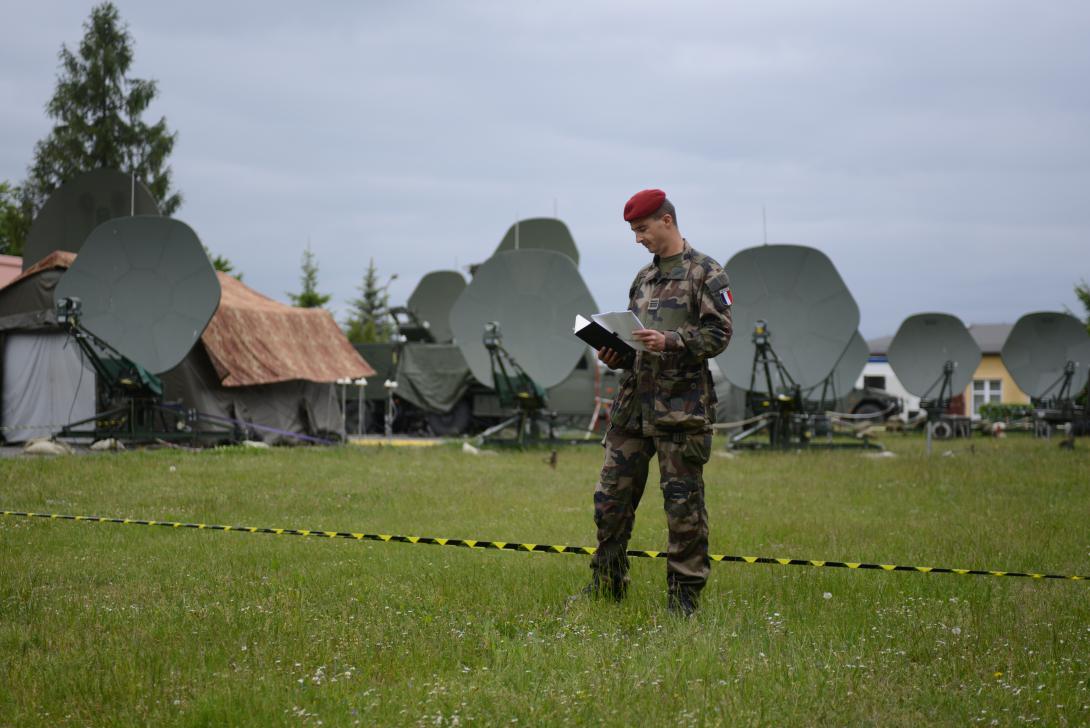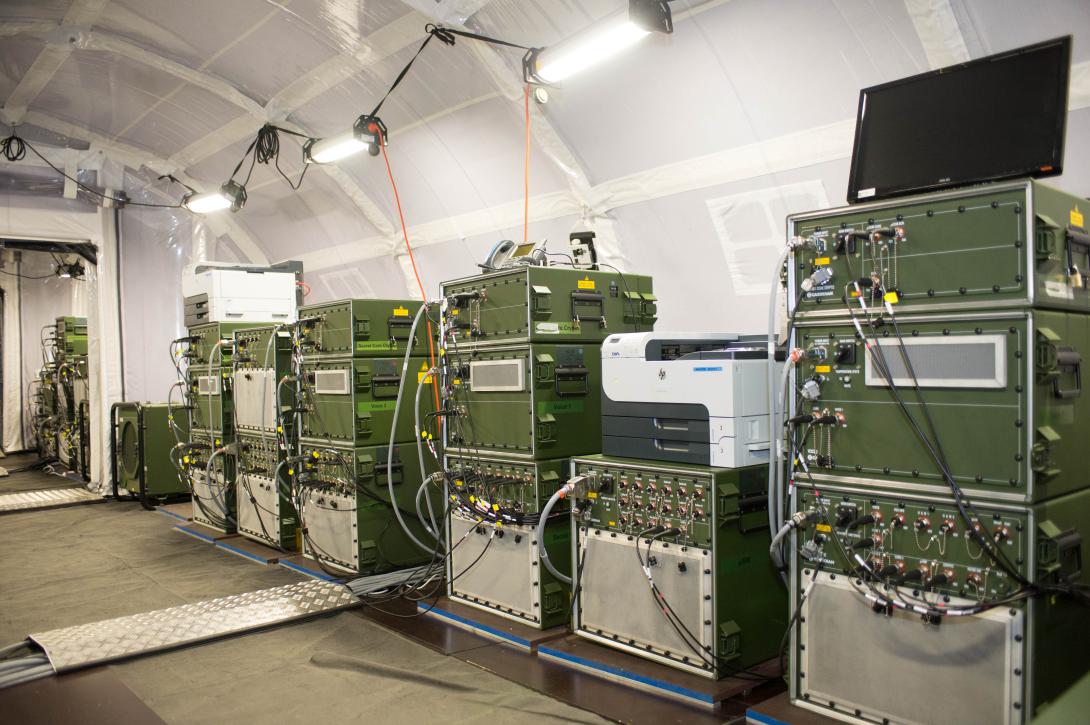NATO Tests Response Force Communications
A recent NATO exercise in Eastern Europe established criteria for NATO Response Force communications, including new technologies and cybersecurity, that will be essential if the rapid-reaction unit is called on in the event of a crisis imposed on an alliance member. The test of communications and information systems set the stage for an overall force exercise later this year, and it substantiated a broader concept of networking across NATO.
Known as Steadfast Cobalt 15, the training event was geared toward preparing the 2016 NATO Response Force (NRF). About 39 organizations from 25 nations contributed to the exercise, which took place over two weeks in late May and early June in Walcz, Poland. Steadfast Cobalt 15 established the groundwork for the NRF full-scale Trident Juncture exercise in October.
NATO has prioritized such exercises to reassure its easternmost nations worried by Russia’s aggressive statements and actions. NATO’s Readiness Action Plan seeks to address contingencies emerging from these concerns, and the NRF is part of that new security environment. The alliance is working to implement into the NRF the Very High Joint Readiness Task Force (VJTF), described as a spearhead force for rapid reinforcement.
Maj. Gen. Thomas Franz, GEAF, was the commander, NATO Communications and Information Systems Group (NCISG), during Steadfast Cobalt 15. NCISG comprises information technology troops from 20 nations sited at locations throughout Europe, from Lithuania to Turkey. These NCISG personnel establish their presence and operations before regular forces arrive in theater, and Gen. Franz offers that signals operations will require an even higher readiness posture than the troops that will be supported. Steadfast Cobalt 15 tested the VJTF approach amid its multiday operations.
Gen. Franz notes that the exercise had two main objectives. First was preparing and certifying communication systems for the NRF. This entailed establishing networks as they would be configured for an NRF-deployed operation.
Second was testing the baseline for what will become NATO’s Future Mission Network (FMN), also known as Federated Mission Networking. The FMN is an outgrowth of the Afghan Mission Network (AMN), which linked the diverse militaries of the International Security Assistance Force (ISAF) in a single information infrastructure. The AMN demonstrated how NATO members could be connected in a coalition operation, and its approach is being applied to the development of the FMN. Without the practical and positive example of the AMN, convincing NATO members of the utility of the FMN—along with conceiving the advanced network—would have been difficult, the general maintains.
Gen. Franz is not hesitant in describing the worth of Steadfast Cobalt 15. “It was a very successful exercise,” he declares. “We are ready to go for the NRF. We did not have any major deficiencies. For the FMN, we discovered we have a useful baseline for establishing a mission network that covers minimum requirements for [most operations].
“What we will have in the future is a pre-defined, prepared network that is flexible enough to be used for any operation, wherever it will be and whatever coalition we will have,” the general emphasizes.
While the results of Steadfast Cobalt 15 will not change the way the NRF will operate, the exercise has highlighted requirements in the communications and information systems (CIS) realm for NRF success, Gen. Franz maintains. These range from the FMN concept to interoperability on the tactical level.
Interoperability issues came to the fore on several levels during the exercise, Gen. Franz allows. However, technical troubles took a back seat to cultural challenges. Processes, in particular, posed a problem among the different organizations.
The CIS signal support group helps overcome some of these theater interoperability challenges through a deployed network operating center, or DNOC. Steadfast Cobalt 15 represented the first full theaterwide use of a DNOC, Gen. Franz points out. “Without such a clear organization with clear processes, you never will be able to run such a complex network,” he says.
Gen. Franz characterizes interoperability between strategic and operational levels as “more or less guaranteed 100 percent,” because the NATO command structure is supported by the NCISG. Down the line, force elements are provided by the NATO force structure, in which individual nations play a role in determining interoperability. Some concerns emerge there, but overall interoperability between the strategic and operational levels is quite good, the general says.
Interoperability on the tactical level is a different challenge, especially with the distinct warfighting domains. NATO’s air domain has good interoperability, as does the maritime domain. However, the land domain continues to have many difficulties that Gen. Franz describes as deficiencies. In the land domain, an interoperability gap exists between the operational level and the tactical level, he declares.
“In some respects, we will be able to overcome that with the implementation of Federated Mission Networking,” he allows. But mobile elements still face challenges, and many nations have different solutions that may or may not be interoperable. This is evident with VHF or HF mobile systems, which tend not to interoperate at the battalion or company level.
The short-term solution is to move up communications to a command level where interoperability is not a problem, and then move vital information down the chain. The brigade-level VJTF headquarters would serve that purpose, the general offers.
In the land component of the VJTF, as many as six different nations may be providing forces. Yet its long-term rotation plan will enable a level of interoperability. Also, the NCISG will support the VJTF headquarters, which will ensure the necessary interoperability at that level.
Above all, it will be up to NATO nations to follow common alliance interoperability standards for their procurements, Gen. Franz emphasizes. “In most cases, the standards are there,” he says. “They [the nations] just have to follow them.”
Steadfast Cobalt 15 also included several examples of new technology insertion, which Gen. Franz says largely worked well. Virtually every technology evaluated proved useful, although some illustrated that they need improvement.
For example, the Dragonfly communications system was employed for the first time in a large exercise. Evaluators learned that it needs “some technical refreshment,” the general offers, citing its inability to connect the necessary number of end users. That number has grown since the system was developed a few years ago, and the system’s capacity needs to be increased.
Such issues play into future networking. The technical challenge for achieving interoperability with the FMN is “not that big,” Gen. Franz says. But agreeing on functional services is important, especially as some areas feature as many as six or seven different types. NATO needs to establish which one will serve which area rather than have many different functional services that are complicated and increase stress on training.
One positive sign from Steadfast Cobalt 15 is that network collaboration and cooperation among the different nations has improved greatly since past efforts, Gen. Franz states. The complex network established during the exercise could not be operated effectively without all the participants accepting its rules and processes, he notes. Any need for slight adjustments or technological changes to improve interoperability was accommodated.
The new European security environment, with its growing threat from Russia, may have been a motivator for this improved cooperation, the general observes. The danger to the eastern members of the alliance no longer is just theoretical, he points out. The need for running these networks and the importance of interoperability is clearer now.
Cyber was an element of Steadfast Cobalt 15 as well, although the focus was on defensive operations per NATO policy. This effort largely entailed hardening systems and networks, the general says. Last year, individual nations performed their own cyber measures. Now, because cooperation among nations has improved, participants achieved common solutions for hardening systems and networks.
The exercise ran several penetration tests, and preliminary findings indicated the hardening and protection measures worked “pretty well,” Gen. Franz allows. However, in some cases, the skill sets of system administrators fell short. This inexperience caused situations where firewalls were not completely installed, he says.
Steadfast Cobalt 15 had red teams performing cyber tests, but these teams were limited in their activities, Gen. Franz admits. They were not allowed to undertake unlimited cyber attacks that could have brought the entire exercise to a halt. This might take place in follow-on exercises, he suggests, but for Steadfast Cobalt 15, the red teams focused on individual areas.
The results of the Steadfast Cobalt 15 cyber tests did not point out any need to change the way the NRF operates, the general offers. However, the results made clear that anything preventing the establishment of an FMN will lead to failure. The ability to operate an NRF depends on the FMN, he emphasizes. “If some nations did not realize that this [FMN] is the way to go, now they do,” he says.
And everything has a price tag. Planners may overlook that dollars or euros must be spent to achieve necessary CIS operational readiness. This includes logistics and strategic CIS asset deployability, for example. “Our nations will have to pay the price,” the general points out. “Otherwise, we won’t be able to meet our targets.”
Gen. Franz warrants that Steadfast Cobalt 16 will have a larger scope and scale than the 2015 version. Consequently, nations might need to commit additional resources for CIS, including specialized troops.







Comments